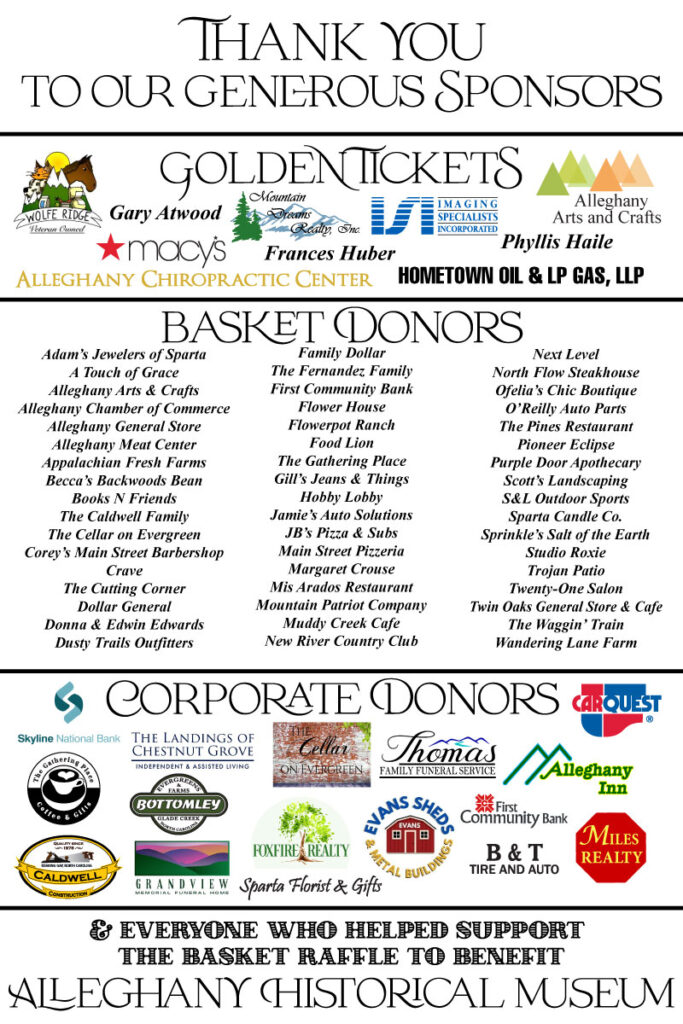Here is one of the newest additions to the Alleghany Historical Museum. It’s a single page (now in three parts due to its age) bearing a handwritten song lyric that fills both sides of the sheet. It is undated and unsigned except for the name W.B. Estep, which is written, upside-down, at the top of side one.


I say “unsigned,” because, although Mr. Estep might have written it, I don’t think he was the author. Wilborn Berry Estep (1874-1941) lived at Whitehead, North Carolina. His granddaughter was Irene Richardson Wagner. Irene was a charter member of the Alleghany Historical – Genealogical Society, and she passed away in 2019. Her son, Ross Wagner, donated his great-grandfather’s manuscript to the museum.
The song is called “The Ore Nob Song” and tells the story of a cave-in at the Ore Knob Copper Mine in neighboring Ashe County in the 1800s. The event was tragic in that two men were killed and two others were injured. We had heard of the song. Somewhere along the way, I’d seen a transcript. It mentions the surnames of the two men who lost their lives, Smith and Sherly, but it gives no dates or any other personal info, except that Sherly had a family and Smith was unmarried and lived with his mother.
So I started looking. I thought it would be a snap. A story like this would have made the papers. And I’d easily find the men on genealogy apps. But it wasn’t so easy.
Initially, I found two versions of the music and several variations of the lyrics in the Special Collections Research Center archive at Appalachian State. The lyrics closely matched what Mr. Estep had written down. But there were no dates on any of the documents. And no songwriter was listed. Except for the name Chas. Liddle at the end of one of the sheets along with a second, unintelligible name.
I also found a listing in an archive at Middle Tennessee State University, for another lyric manuscript called “The Oar Knob Song.” But I couldn’t see the actual file. It looks like it is only available at archive.org and that site is temporarily (I hope) inaccessible.
In the description of the MTSU document, however, it said:
1 sheet with handwritten lyrics…
Inscription beneath the lyrics reads: “Rote June the 27 : 1879, James M. Wilson”.
Inscription on the back of the page reads: “Bettie Calloway, Old Town Grayson Co., Va”.
Most likely a reference to Ore Knob Mine in Ashe County, North Carolina.
So I looked and was able to find both names from that document, “James M. Wilson” and “Bettie Calloway” in the 1870 census living next door to each other, at Old Town in Grayson Co. Virginia. James (Madison) Wilson was 13-years-old in 1870 making him 22 if/when he wrote the page and Elizabeth “Bettie” was 8, so 17 or so in 1879. (They’re also both listed in the 1880 census, still in Old Town, but they weren’t close neighbors any more.)

On the same page of the 1870 census, there is a family headed by Elizabeth “Betsy” (Wilson) Liddle. She had a son named Thos. C. Liddle (remember, one of the ASU sheets is signed Chas. Liddle.)

It’s conceivable that men from Grayson County were working at the mine in Ashe at the time of the accident and Miss Calloway, the Wilson’s and the Liddle’s might have all been involved in the writing of the song.
This, of course, is conjecture. I’d welcome someone’s help with actual facts.
Now, about Sherly and Smith. I went straight to the horse’s mouth on this one- the Ashe County Historical Society’s blog and an excellent article on the history of the Ore Knob Copper Mine by our friend, Josh Beckworth.

…the community that developed around the copper mine was surprisingly populated. In 1880, the entire county of Ashe had a population of 14,447 people, approximately 28 people per square mile. However, the one mile square area around the Ore Knob mine recorded nearly 500 residents. These residents formed a well developed community that included a hall for dances, a church, and numerous stores.
…this booming community became a powerhouse of copper extraction. In fact, it was for a time, one of the largest copper mines operating in the United States. Millions of pounds of ore was extracted, sorted, and smelted through a variety of processes. In 1879, the mine was reported as producing 90 tons of copper ore per day.
www.ashehistoricalsociety.org
Josh had helpfully included a newspaper clipping, there, that listed the men’s given names: Henry Shirley and Harold Smith and a date for the tragic event: 1876. That date fit with the MTSU document of 1879.

I asked Josh if he had other info on the accident at Ore Knob. He let us know that his original clipping came from the April 13, 1876, edition of the Goldsboro Messenger. He also sent us a second article— this one (with the same date, but from the People’s Press of Winston-Salem) told where the men came from. Harrell Smith was from Davidson County and Henry Sherley was from Guilford.

The article also gave a firm date for the event- March 28, 1876.
With this information, we were able to find in the 1870 census:
Herald Smith of Silver Hill in Davidson County, NC. Herald’s occupation, entered there, “Work in Silver M.” Production at the Silver Hill Mine in Davidson (the first silver mine in the United States) began in 1839 but had dropped off in the 1870s and it was mostly shut down by 1882. It makes sense that a young man like Herald- 23 in 1876- might travel to “one of the largest communities in Ashe County at the time,” for work in which he was already experienced.
We also found:
Henry W. Shirley of Friendship in Guilford County, North Carolina, who would have been 31 in 1876, was married to Mariam Becknell Shirley. They had 2 children and his occupation is listed in the 1870 census as “miner.”


Neither Herald Smith, nor Henry W. Shirley are listed in the 1880 census.
The Ore Knob Song
(Variation from the Estep Family of Whitehead, NC)
Come bloomin youth in the midst of day,
And see how soon some pass away.
There were two men worked with us here,
What become of them you soon shall here.
They worked all day till even time,
Before they groaned, or made a scythe.
At fifty minutes after five
They were healthy men, and yet alive.
Before the whistle blew for six,
There die was cast, there dom was ficts.
The rocks and dirt came tumbling down,
And under there those men were found.
Both cold and dead,and could not live,
For God had took the spark he give.
They was brought to the top, a dreadful sight,
How lonesome was that Tuesday night.
Poor Sherly and Smith! how much we miss
Them round the Ore Knob today!
We hope they have gone to a world of bliss
But none of us we dare not say.
For with the Lord there is nothing strange,
He could their hearts in a moment change.
We hope there hearts He did renew,
And receive them in that heavenly crew.
Poor Sherly had a wife and children, dear,
And Smith, a Mother, this news to hear.
We hope the[y] will for consolation
Read and believe in Johns revelation,
That says the dead will one day rise,
And saints shall mount the upper [skies?],
Too sing,with angels and adore,
Where friends that mee[t] will part no more.
Let us take heed what the scriptures say
That we must watch as well as pray,
For in an hour when least is thought,
The summons of death, it may be brought.
You can hear a beautiful rendition of the song, performed by Mary Jane Miller at the 43rd Annual Old Fiddlers Convention (at Galax in 1978), here
[07:18] A5 – The Ore Knob [Mary Jane Miller]


























